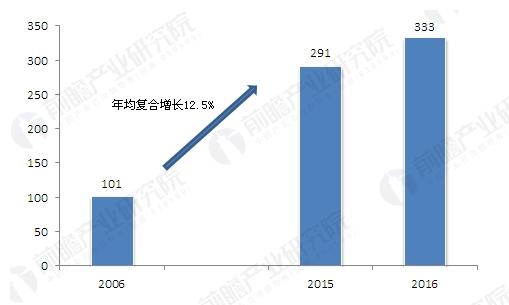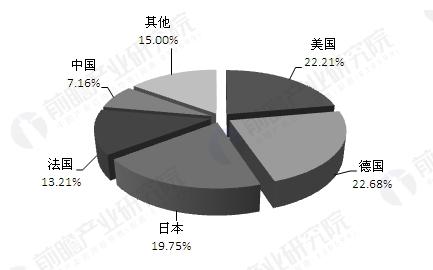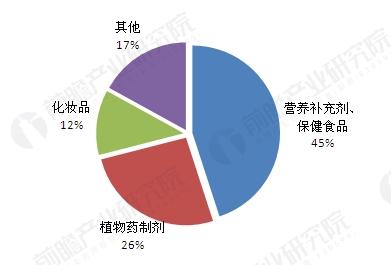China's plant extractive industry is currently the most likely sub-industry in the field of Chinese medicine, but due to the inconsistency of standards and lack of corresponding market supervision departments, it is difficult to form industry self-discipline and industrial concentration, resulting in many companies still remain in the chemical industry category , And the overall size of the company is too small, the international competitiveness is not strong, in the future to become a powerful plant extraction industry there is still a long way to go.
International Plant Extract Market Status
In recent years, the steady increase in the demand for plant extracts in developed countries and regions in the world, especially in Europe and the United States, has greatly stimulated the development of the industry. In 2006, the global sales of plant extracts reached US$10.14 billion, reaching US$33.32 billion in 2016, and the average annual market development rate was approximately 12.63%.

Global Growth of Plant Extract Market in 2006-2016 (Unit: Billion US Dollars, %)
Under the background of the growing scale of the global herbal market, the global market for plant extracts continued to rise in 2016, and it has already formed a four-strong US, De, Japan, and France. The German market for plant extracts has developed at a faster rate and has surpassed the United States. Plant extracts account for 22.68% of the world's total; while the United States still maintains a major advantage, accounting for 22.21% of the scale; followed by Japan, its plant extracts The global market share of material market is 19.75%, which is about to break through 20%; France accounts for 13.21%. After rapid development in recent years, China has become increasingly important in the global market. The market share of plant extracts has reached 7.16%.

Global Distribution of Plant Extract Market in 2016 (Unit: %)
In addition, plant extracts are the main raw materials for botanical preparations in major consumer markets in the West, especially in Europe, and in the markets of North America and Japan, they are mainly used in nutritional supplements, health foods, cosmetics and other industries, and are natural health products. The core product of the market.

Global Plant Extract Application Structure Distribution (Unit: %)
The international competitiveness of plant extracts in China needs to be improved
From 2010 to 2015, China's overall export volume of the plant extract industry has grown from less than US$1 billion to more than US$2.5 billion. The annual increase in the export scale of plant extracts in China can not be separated from the technical breakthroughs and model innovations that have been continuously achieved by the private enterprises in China for many years; nor can the policies and incentives of the national policies on the export of the industry are indispensable; at the same time, the process of accreditation of industry standards has accelerated. It also objectively promotes China's continuous integration with international plant extracts and even its leading position. Driven by many parties, the international competitiveness of China's plant extracts industry is constantly improving.
However, after the international financial crisis, the three major markets in Europe, the United States, and Japan have shown a strong localization trend. They have imposed new requirements on the prices, costs, and safety of extractive products. Chinese companies are facing international markets. challenge.
The first is the localization trend that each market presents. The European market promotes unsaturated fatty acid products, mainly originating in Norway and other Nordic countries; the Japanese market has become the mainstream product of fermentation and bean products, while China has few such products; the top seven products in the US market are localized products. Weakening the trend of Chinese products.
Second, global extract product innovation is slow, prices and costs have become the focus of competition, and the days when Chinese companies originally relied on large companies in Europe and America to launch star products every year to drive the market are gone forever.
Third, Chinese extract products are becoming a synonym for “big goods†and “cheap goodsâ€. Once they are “namedâ€, market competitiveness will be difficult to guarantee, and the development of the market will be worrisome.
Under this situation, China's plant extracts enterprises must improve their competitiveness as quickly as possible, and plan and upgrade their products, standards, quality control, innovation capabilities, and corporate development strategies in order to promote the healthy development of China's extractive industries.
OVERFLY is the electric bike brand of China. Since its establishment in 2005, Overfly focus on the R&D and manufacturing of electric bike and electric scooter ever since. With years development, Overfly electric bike successfully expanded to European, North American and Oceania markets, and occupied a certain market share. In order to solve the production origin issue, and provide more options for customers, OVERFLY developed and owns two production bases, one in Yongkang, Zhejiang, and second in Taichung, Taiwan. Also established German branch for better service.
Electric Bike,City Ebike,Commuter E Bikes,Commuter City Bike
ZHEJIANG XINGYUE OVERFLY ELECTRIC VEHICLE CO., LTD , https://www.overflyebike.com